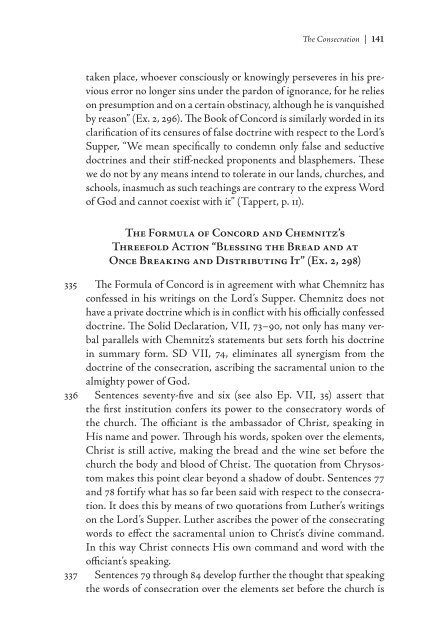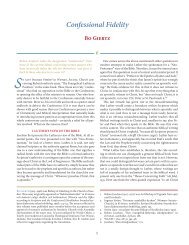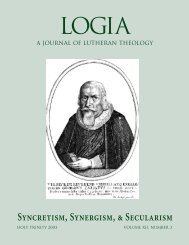The Lord's Supper in the Theology of Martin Chemnitz Bjarne - Logia
The Lord's Supper in the Theology of Martin Chemnitz Bjarne - Logia
The Lord's Supper in the Theology of Martin Chemnitz Bjarne - Logia
Create successful ePaper yourself
Turn your PDF publications into a flip-book with our unique Google optimized e-Paper software.
<strong>The</strong> Consecration |<br />
taken place, whoever consciously or know<strong>in</strong>gly perseveres <strong>in</strong> his previous<br />
error no longer s<strong>in</strong>s under <strong>the</strong> pardon <strong>of</strong> ignorance, for he relies<br />
on presumption and on a certa<strong>in</strong> obst<strong>in</strong>acy, although he is vanquished<br />
by reason” (Ex. 2, 296). <strong>The</strong> Book <strong>of</strong> Concord is similarly worded <strong>in</strong> its<br />
clarification <strong>of</strong> its censures <strong>of</strong> false doctr<strong>in</strong>e with respect to <strong>the</strong> Lord’s<br />
<strong>Supper</strong>, “We mean specifically to condemn only false and seductive<br />
doctr<strong>in</strong>es and <strong>the</strong>ir stiff-necked proponents and blasphemers. <strong>The</strong>se<br />
we do not by any means <strong>in</strong>tend to tolerate <strong>in</strong> our lands, churches, and<br />
schools, <strong>in</strong>asmuch as such teach<strong>in</strong>gs are contrary to <strong>the</strong> express Word<br />
<strong>of</strong> God and cannot coexist with it” (Tappert, p. 11).<br />
<strong>the</strong> Formula <strong>of</strong> concord and chemnitz’s<br />
threefold Action “Bless<strong>in</strong>g <strong>the</strong> Bread and at<br />
once Break<strong>in</strong>g and Distribut<strong>in</strong>g it” (ex. 2, 298)<br />
335 <strong>The</strong> Formula <strong>of</strong> Concord is <strong>in</strong> agreement with what <strong>Chemnitz</strong> has<br />
confessed <strong>in</strong> his writ<strong>in</strong>gs on <strong>the</strong> Lord’s <strong>Supper</strong>. <strong>Chemnitz</strong> does not<br />
have a private doctr<strong>in</strong>e which is <strong>in</strong> conflict with his <strong>of</strong>ficially confessed<br />
doctr<strong>in</strong>e. <strong>The</strong> Solid Declaration, VII, 73–90, not only has many verbal<br />
parallels with <strong>Chemnitz</strong>’s statements but sets forth his doctr<strong>in</strong>e<br />
<strong>in</strong> summary form. SD VII, 74, elim<strong>in</strong>ates all synergism from <strong>the</strong><br />
doctr<strong>in</strong>e <strong>of</strong> <strong>the</strong> consecration, ascrib<strong>in</strong>g <strong>the</strong> sacramental union to <strong>the</strong><br />
almighty power <strong>of</strong> God.<br />
336 Sentences seventy-five and six (see also Ep. VII, 35) assert that<br />
<strong>the</strong> first <strong>in</strong>stitution confers its power to <strong>the</strong> consecratory words <strong>of</strong><br />
<strong>the</strong> church. <strong>The</strong> <strong>of</strong>ficiant is <strong>the</strong> ambassador <strong>of</strong> Christ, speak<strong>in</strong>g <strong>in</strong><br />
His name and power. Through his words, spoken over <strong>the</strong> elements,<br />
Christ is still active, mak<strong>in</strong>g <strong>the</strong> bread and <strong>the</strong> w<strong>in</strong>e set before <strong>the</strong><br />
church <strong>the</strong> body and blood <strong>of</strong> Christ. <strong>The</strong> quotation from Chrysostom<br />
makes this po<strong>in</strong>t clear beyond a shadow <strong>of</strong> doubt. Sentences 77<br />
and 78 fortify what has so far been said with respect to <strong>the</strong> consecration.<br />
It does this by means <strong>of</strong> two quotations from Lu<strong>the</strong>r’s writ<strong>in</strong>gs<br />
on <strong>the</strong> Lord’s <strong>Supper</strong>. Lu<strong>the</strong>r ascribes <strong>the</strong> power <strong>of</strong> <strong>the</strong> consecrat<strong>in</strong>g<br />
words to effect <strong>the</strong> sacramental union to Christ’s div<strong>in</strong>e command.<br />
In this way Christ connects His own command and word with <strong>the</strong><br />
<strong>of</strong>ficiant’s speak<strong>in</strong>g.<br />
337 Sentences 79 through 84 develop fur<strong>the</strong>r <strong>the</strong> thought that speak<strong>in</strong>g<br />
<strong>the</strong> words <strong>of</strong> consecration over <strong>the</strong> elements set before <strong>the</strong> church is




